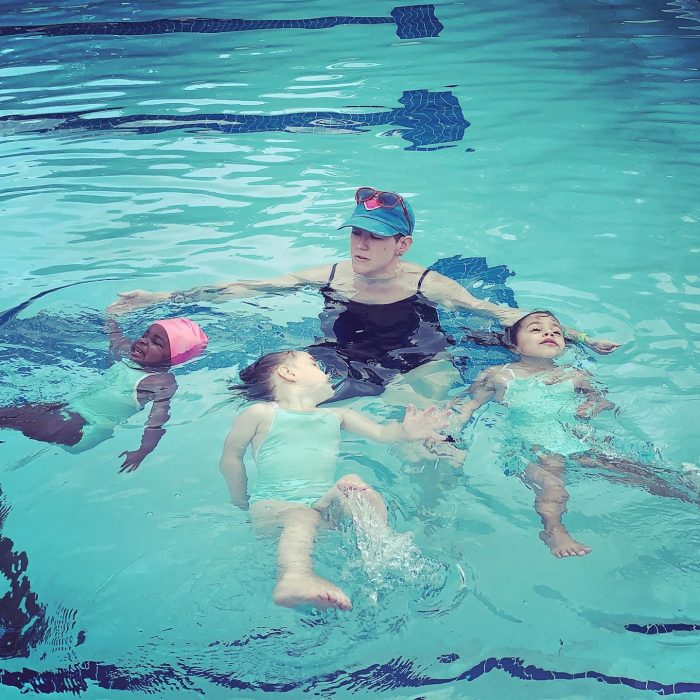Last summer, when my daughter was two years old, I took her and our other kids to the community pool. My daughter had been wearing a puddle jumper, and I took it off for a snack. When I turned to the side to get food, everything was expected, but when I turned back, SHE WAS GONE. I scanned the pool area; she wasn’t anywhere. I will never forget the fear I felt inside. My stomach was tight, my heart was racing, and I knew this child could run fast and disappear easily. I raced to the pool, and my oldest daughter, then 10, said, “She tried to get in, but I stopped her.” I never loved my oldest child more than in that moment for saving her sister.
Drowning is the leading cause of death in children under the age of four.
Puddle jumpers, like the one my daughter was wearing, teach kids that they can swim when they can’t. After thanking her sister, I scolded my two-year-old and told her she was being unsafe. The next time we went swimming, I took off her puddle jumper, and she pulled away from me, saying, “I swim.” because in her two-year-old brain, she could swim. With the puddle jumper on, she floated and swam, which meant she was safe in the water.
“I became an instructor because I wanted a fun job, I could do that allowed me to work with kids. In the end, I have a passion for making sure every child can swim.”
– Jolene ISR Instructor
A month later, we took a trip down to the coast. We swam in the ocean and again used puddle jumpers. My two-year-old had a blast! When it was time to leave, she ran as fast as she could back to the ocean – bare ass naked – screaming, “I swim!” Once my wife and I grabbed her, we reminded her that she could not swim, but she had heard us saying, “Look at your swimming!” all day. Because we had the “safety” net of the puddle jumper, we had given her a false and dangerous sense of ability.
After we got home, I read a story about a child who drowned in my area. My fear was intense, and I realized I had to do something. Sure, we took the mommy, and me swim classes and the toddler pee wee class, but she still didn’t know how to swim. I googled survival swim lessons. The first few results were from local swim schools. Several moms on my Facebook group pointed me to a popular swim school that children attend once a week for 30 minutes, but I had done those classes already! I kept digging and finally found ISR. I started trying to contact every instructor in my area, but they were all booked. Finally, I found an out-of-state instructor coming down in August for four weeks. (Typical programs are six weeks long.) She took us on as clients, and we enrolled all three of my baby girls. I was the typical nervous wreck mom, sad and stressed that my baby was crying. My two-year-old has left hemispheric cerebral palsy, and I wondered if she could learn this skill. The screening at ISR did allow her to continue with the program, and at the end of four weeks, I watched in awe and amazement as my children “fell” into the water, in full winter clothing, and floated. Did they cry? Of course, but as the instructor said, if they are crying you can find them.
“The Instructor simulated a fall into the pool (gently), more than once, and Elisabeth rolled over before she even came up and floated all on her own and remained in a BEAUTIFUL float until she was picked up. My baby can SELF RESCUE!”
– Sonya ISR Parent and now Instructor
Kids will need a refresher with ISR, though the refresher length depends on the child’s needs. Since my two-year-old had fallen at school and missed class for a week during the first session, we decided to have all three of my daughters retake the entire program. They all cried and whined the first four days, and again, I was upset. On the fourth day of class, though, they connected so strongly with the instructor that they started fighting over who was going first. Every day for six weeks, they argued over whose turn it was to go first, and I watched in amazement as my children learned to swim and float. Swim lessons are great, but ISR is a survival skill. It teaches your children not to die.
Recently, I took my three girls to the pool alone. It was empty except for us, and I had them on the stairs playing. My two-year-old, now three and a half, was determined not to listen. She fell in, and I stepped back from her and watched in amazement as she flipped over and floated. She looked for the pool’s edge and swam, floated, swam, and floated until she arrived. She stood up and said, “I did it!”
It is worth the expense. It is worth the time commitment. It is worth the fear. It is worth my children’s lives. Drowning is the leading cause of death in children under age four. Read that line again. Drowning is preventable. Always remember the first line of protection is adult supervision, then a gate around the pool, and then ISR. The more layers of protection you have, the safer your children can be. We put kids in car seats to keep them safe. We put kids in helmets to keep them safe. Put your kids in ISR to keep them safe.
Remember: Drowning is the leading cause of death in children under four.











Read 0 comments and reply